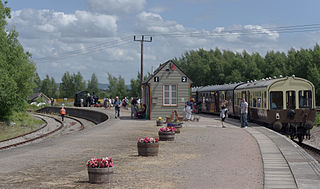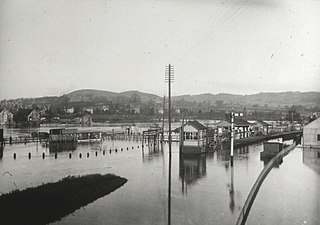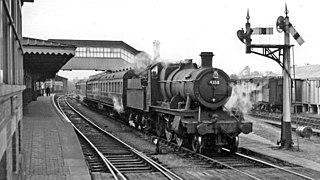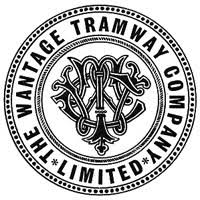
Lydney railway station is a railway station serving the town of Lydney in Gloucestershire, England. It is located on the Gloucester-Newport line, 133 miles 37 chains (214.8 km) from the zero point at Paddington, measured via Stroud. The station is located a mile south of Lydney, and was originally called Lydney Junction, which is now the name of the nearby station on the preserved Dean Forest Railway.

Lydney Junction railway station is a railway station near Lydney in Gloucestershire. The station is now the southern terminus of the Dean Forest Railway. It is located to the south of Lydney, near the A48 road.

The Stourbridge Town branch line is a 0.8-mile (1.3 km) railway branch line, in Stourbridge, West Midlands, England. It is the shortest line in Britain, and could be defined as the shortest line in Europe to host a daily service.

The Severn and Wye Railway began as an early tramroad network established in the Forest of Dean to facilitate the carriage of minerals to watercourses for onward conveyance. It was based on Lydney, where a small harbour was constructed, and opened its line to Parkend in 1810. It was progressively extended northwards, and a second line, the Mineral Loop was opened to connect newly opened mineral workings.

The Wye Valley Railway was a standard gauge railway that ran for nearly 15 miles (24 km) along the Lower Wye Valley between the towns of Chepstow and Monmouth, crossing several times between Wales and England. Opened on 1 November 1876, it was leased to, and worked by, the Great Western Railway (GWR), before being fully absorbed by the GWR in 1905.

Berkeley railway station served the town of Berkeley in Gloucestershire, England. The station was on the Sharpness Branch Line, part of the Midland Railway (MR), which connected the Bristol and Gloucester Railway main line at Berkeley Road station with the docks at Sharpness.

Monmouth Troy was one of the two former railway stations at Monmouth. It was built in 1857 by the Coleford, Monmouth, Usk and Pontypool Railway and was used by several other branch lines as the local rail network expanded. The station closed in January 1964 following the closure of the last two lines to the station, the Wye Valley Railway and the Ross and Monmouth Railway.
The Coleford Railway was a railway company that constructed a short railway from near Monmouth to Coleford, close to the Forest of Dean. The company was sponsored by the Great Western Railway. It was built on part of the course of the Monmouth Railway, a horse-operated plateway, and it was intended that its primary business would be the conveyance of minerals and forest products from the Forest of Dean.

The Coleford, Monmouth, Usk & Pontypool Railway (CMU&PR) was a standard gauge railway of 16 miles (26 km) which ran from Monmouth to Little Mill, near Pontypool in Monmouthshire, Wales. It was intended to convey the mineral products of the Forest of Dean to the ironworks of South Wales, by connecting to the Newport, Abergavenny and Hereford Railway at Little Mill Junction. The NAHR made the onward connection over its Taff Vale Extension line. The CMU&PR intended to acquire the Monmouth Railway, actually a horse-operated plateway, and convert it to locomotive operation.

The Ross and Monmouth Railway was a standard gauge railway of 13 miles (21 km) which ran between Ross-on-Wye, in Herefordshire, England and Monmouth, Wales.

Monmouth Mayhill railway station is a disused railway station on the Ross and Monmouth Railway which was opened in 1873 and closed in 1959. It was one of two stations that served the town of Monmouth, Wales and was situated on the opposite bank of the river River Wye from Monmouth. It was the initial terminus of the line, but the line was extended across the River Wye to the junction station of Monmouth Troy in 1874 with the construction of the Duke of Beaufort Bridge.

Kerne Bridge railway station is a disused railway station on the Ross and Monmouth Railway constructed in the Herefordshire hamlet of Kerne Bridge which also served the village of Goodrich across the River Wye.
Walford Halt railway station is a disused halt on the Ross and Monmouth Railway constructed near the Herefordshire village of Walford. It also served the surrounding settlements. Nothing remains of the station. It was located approximately 3 miles and 12 chains along the railway from Ross-on-Wye station.

Ross-on-Wye railway station is a former junction railway station on the Hereford, Ross and Gloucester Railway constructed just to the north of the Herefordshire town of Ross-on-Wye. It was the terminus of the Ross and Monmouth Railway which joined the Hereford, Ross and Gloucester Railway just south of the station.
Monmouth Troy Goods Yard was a large goods yard near Monmouth Troy railway station in Monmouth, Wales. It was opened in 1857 by the Coleford, Monmouth, Usk and Pontypool Railway at the same time as the station. As other railways reached Monmouth Troy the goods yard grew in importance. At its height, the goods yard was used by the Wye Valley Railway, Coleford Railway, Ross and Monmouth Railway as well as the Coleford, Monmouth, Usk and Pontypool Railway. The goods yard closed in 1964 when the last two railways, the former Wye Valley Railway and Ross and Monmouth Railway, closed. The non-rail depot remained open until October 1964.

The Wantage Tramway Company was a two-mile tramway that carried passengers and freight between the Oxfordshire town of Wantage and Wantage Road Station on the Great Western Main Line in England. Formed in 1873 to link Wantage Road station with its terminus at Mill Street, Wantage the line was cheaply built parallel to what was then the Besselsleigh Turnpike, and now the A338. The tramway closed to passengers in 1925 and to goods traffic in 1945.

Usk (GWR) railway station is a disused railway station in the town of Usk, Monmouthshire, Wales. The station is now barely recognisable with the remains of the platforms beneath undergrowth, but the trackbed, the adjacent Usk Tunnel and road and river bridges remain extant and can be walked.
The Monmouth Railway, also known as the Monmouth Tramroad, was a horse-drawn plateway of 3 ft 6in gauge. It ran for about 5 miles (8.0 km) from Howler's Slade, east of Coleford, in Gloucestershire and Monmouth; there were two branches from other mineral sites. It was intended to bring mineral products of the Forest of Dean to Monmouth, and to the works alongside the River Wye.

Speech House Road railway station is a disused railway station opened by the former Severn and Wye Railway in 1875, it remained open for 88 years until the line, north of Parkend, closed to freight in 1963. Passenger trains on the Severn and Wye Railway, north of Lydney, were withdrawn from 1929.

Little Mill Junction was a station on the former Coleford, Monmouth, Usk and Pontypool Railway, located between the main Newport, Abergavenny and Hereford Railway line and the branch to Usk. It served the village of Little Mill, Monmouthshire.















